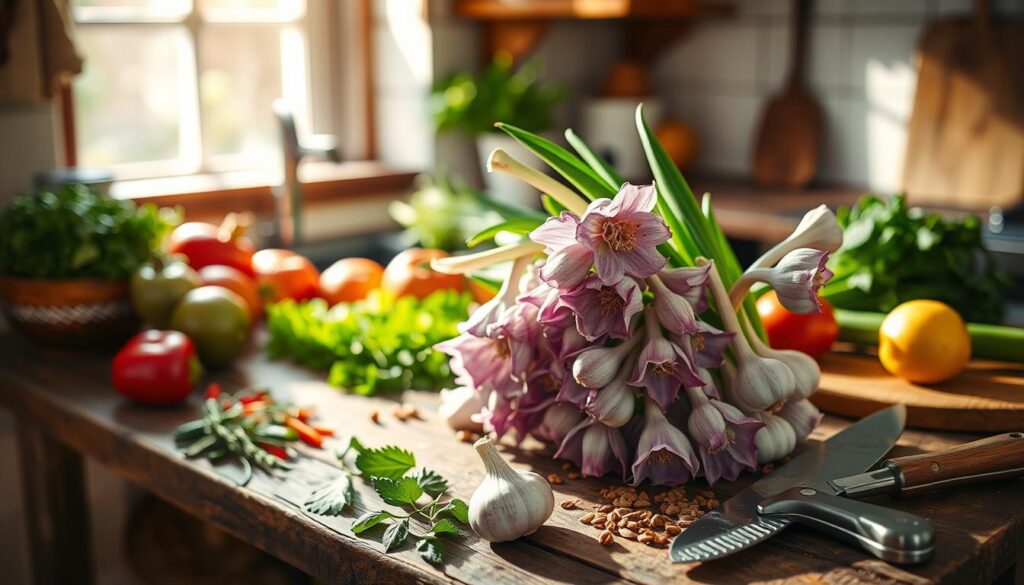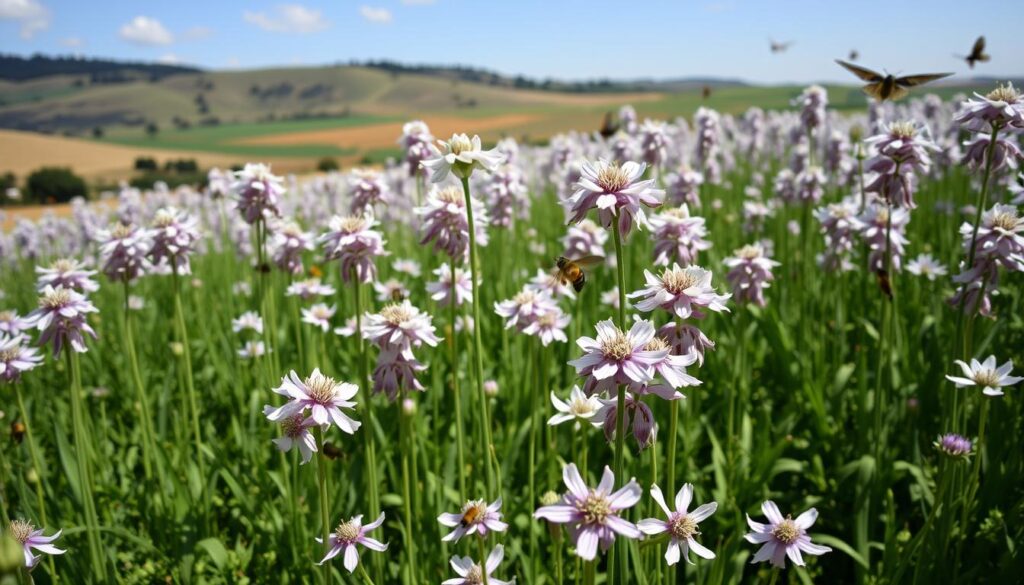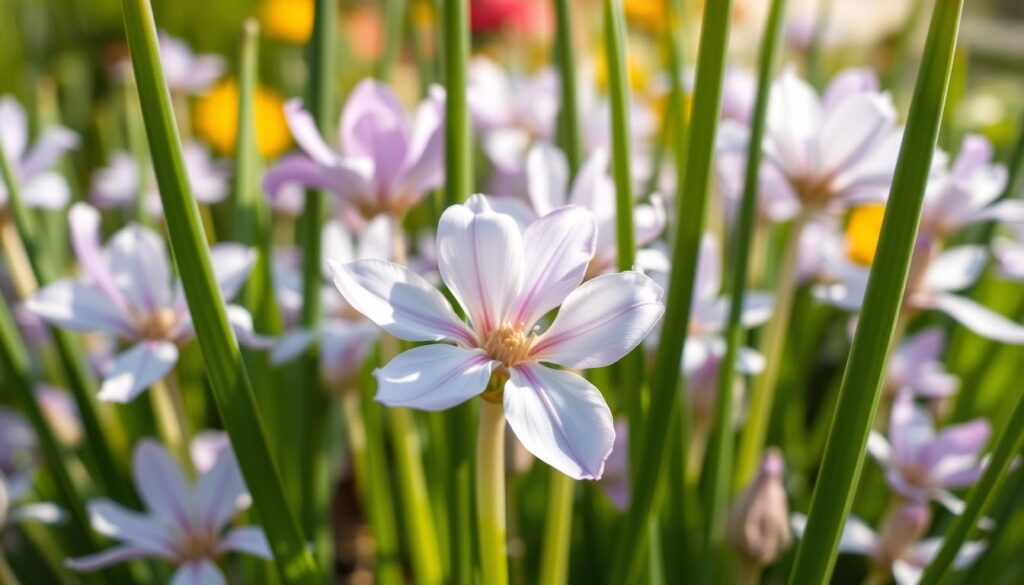Garlic flowers, also known as garlic plant flower, are a delicate and often overlooked part of the garlic plant. These flowers have a unique characteristic that sets them apart from other plants. Their beauty is worth exploring. For those interested in learning more about garlic flowers, visiting the garlic flower page can provide valuable insights into their growth and care.
Garlic flowers have been a part of historical cultivation and presence in Ireland. Photographic representations date back to the early 1900s. The abundance of natural beauty in the Irish countryside before industrialization and urbanization shows the high density of wild garlic flowers in the area.
Table of Contents
Key Takeaways
- Garlic flowers are a unique and often overlooked part of the garlic plant.
- They have a delicate appearance and are worth exploring for their beauty.
- Garlic flowers have been a part of historical cultivation and presence in Ireland.
- They can be used in various ways, including in floral arrangements and as a culinary ingredient.
- Understanding the growth and care of garlic flowers can help gardeners cultivate and utilize these remarkable blooms.
- Garlic plant flower can add a touch of elegance to any garden or indoor space.
- Learning about garlic flowers can empower gardeners to appreciate and care for these beautiful plants.
What Are Garlic Flowers?
Garlic flowers, also known as garlic bloom or garlic blossom, grow on garlic plants in summer. They have delicate white petals and a sweet smell. If garlic plants flower, they might grow smaller bulbs.
They go through different stages, from bud to full garlic bloom. Their growth depends on climate, soil, and sunlight. For instance, hardneck garlic flowers in summer, while softneck varieties flower under stress.
- Delicate white petals
- Sweet fragrance
- Grow on tall stems or scapes that can reach up to 1 meter tall
Garlic flowers form in round clusters and can be white or pink. Letting garlic plants flower adds beauty and gives edible scapes.
The Life Cycle of Garlic Plants
Garlic plants grow through several stages, from seed to flower. This whole process can last 5 to 10 months. When they flower, it means they are ready. A garlic plant blooms is a beautiful sight, with white or purple flowers in summer.
The growth of garlic plants depends on temperature, moisture, and fertilization. For example, hardneck garlic needs a cold period to split cloves. This affects planting times for fall and spring. Here are some important factors:
- Plant spacing: at least 8 inches apart to reduce competition among bulbs
- Soil quality: well-draining soil with a pH between 6.0 and 7.0
- Watering: consistent moisture, specially in the first few months
Knowing the life cycle of garlic plants is key for gardeners. By giving the right conditions and care, gardeners can get a lot of garlic. This is great for cooking or for the beauty of garlic plants flowering.
| Stage | Description | Duration |
|---|---|---|
| Germination | Seed germination and initial growth | 1-2 months |
| Vegetative growth | Leaf growth and bulb formation | 3-5 months |
| Flowering | Garlic plant blooms and seed production | 1-2 months |
The Beauty of Garlic Flowers in Gardens
Garlic flowers add a unique beauty to gardens. They can grow up to three feet tall. Their colors range from purple, white, to light pink, making them a stunning sight.
These garlic flowers edible blooms are great for floral arrangements. They add elegance and sophistication. Used as a garnish, they bring a subtle flavor and fragrance to dishes.
Popular varieties include Bai Pai Suan, Brown Rose, and Chimyon. Each has its own look and growth habits. To grow them, you need the right soil and enough fertilizer.
For those curious, what does a garlic flower look like? They bloom in early summer. They have a delicate look and a sweet smell. They are versatile and beautiful in gardens, arrangements, or as food.
| Garlic Flower Variety | Color | Growth Habit |
|---|---|---|
| Bai Pai Suan | White | Upright |
| Brown Rose | Pink | Compact |
| Chimyon | Purple | Tall |
Culinary Uses of Garlic Flowers
Garlic flowers, also known as garlic bulb flowers, are a tasty and versatile ingredient. Many people ask, can you eat them, and the answer is yes. These flowers add a unique flavor and texture to many dishes.
The flavor of garlic flowers is similar to garlic but milder and sweeter. They’re great in soups, salads, and as a garnish. Adding them to pesto sauces makes the dish even more flavorful.
Some popular dishes with garlic flowers include garlic scape pesto, roasted garlic flower soup, and grilled garlic flower skewers. These dishes show how versatile they are. They add depth and complexity to various dishes.

Garlic flowers can be stored for weeks or months in a vegetable drawer. This makes them a great ingredient to have on hand. Whether you’re a seasoned chef or a beginner, they are a great addition to any kitchen.
| Recipe | Ingredients | Instructions |
|---|---|---|
| Garlic Scape Pesto | Garlic scapes, basil, parmesan cheese, olive oil | Blend all ingredients together until smooth |
| Roasted Garlic Flower Soup | Garlic flowers, chicken broth, cream, garlic | Roast garlic flowers and blend with chicken broth and cream |
Garlic Flowers in Traditional Medicine
Garlic has been used in traditional medicine for thousands of years. It comes from places like China, Egypt, Greece, and Rome. The garlic flower bud is a key part of this medicine, bringing many health benefits. But does garlic bloom really change its medicinal powers? Studies show garlic extract fights bacteria, fungi, and viruses, helping treat many diseases.
Some of the key health benefits of garlic flowers include:
- Reducing serum glucose and total cholesterol in diabetic animal models
- Showing anti-inflammatory properties by reducing levels of pro-inflammatory cytokines
- Exhibiting antimicrobial activity against both Gram-negative and Gram-positive bacteria
Garlic flowers, including the garlic flower bud, help with many health problems. These range from heart issues to infections and even cancer. While the question of does garlic bloom is interesting, it’s clear garlic flowers are very important in traditional medicine. They are full of nutrients and offer many health benefits, making them great for any garden or medicinal herb collection.
Understanding garlic flowers’ history and current uses in medicine helps us see their value. Gardeners and health fans can learn about their uses in herbal remedies.
| Health Benefit | Description |
|---|---|
| Antibacterial properties | Garlic extract has demonstrated antibacterial actions, making it relevant in treating bacterial infections |
| Anti-inflammatory properties | Garlic flowers have shown anti-inflammatory properties by reducing levels of pro-inflammatory cytokines |
Attracting Pollinators with Garlic Flowers
Garlic flowers are a rare treat for pollinators, giving them nectar and pollen. Bees and butterflies love them, which is key for pollination. By adding garlic flowers to your garden, you help the local pollinators and keep your ecosystem healthy.
Garlic flowers can’t pollinate themselves. They need bees and butterflies to help them. Planting garlic with other pollinator-friendly plants like marigolds and lavender is a great idea. This makes your garden a welcoming place for pollinators, helping your garden stay healthy and productive.

Here are some ways to attract pollinators with garlic flowers:
* Plant a mix of flowers that bloom at different times for a steady supply of nectar and pollen.
* Stay away from pesticides and chemicals that harm pollinators.
* Offer water, like a shallow dish or birdbath, for pollinators to drink.
* Make your garden a pollinator-friendly habitat by adding native plants and reducing lawn area.
By following these tips and planting garlic flowers, you support local pollinators and help your garden thrive. Garlic flowers are great for your garden’s ecosystem. With a bit of planning, you can make your garden a haven for pollinators.
Growing Garlic Flowers at Home
Garlic flowers, also known as garlic bloom or garlic blossom, can be grown at home. The right conditions are key for a successful garlic once flowered. This means keeping the temperature between 60-80°F (15-27°C) and ensuring the soil is moist, with about 1 inch of water per week.
The soil pH should be between 6.0 to 7.0 for optimal growth. Adding a 3 to 4-inch layer of organic matter, like compost, can also help. It’s important to avoid overwatering or underwatering, as these can harm the garlic bloom.
Some key tips for growing garlic flowers at home include:
- Planting garlic cloves at a depth of 1 to 2 inches in warm climates and 3 to 4 inches in cooler regions
- Adding a 1-inch layer of weed-free mulch to regulate soil temperatures
- Waiting at least 14 days between treating garlic with Sevin Insect Killer and harvesting
For more information on growing garlic, visit this resource on planting garlic bulbils. By following these guidelines and providing the right conditions, you can enjoy a beautiful garlic blossom in your own garden.
With proper care and attention, your garlic once flowered will thrive. You can then enjoy the benefits of homegrown garlic flowers.
The Nutritional Benefits of Garlic Flowers
Garlic plant blooms, also known as garlic flowers, are packed with nutrients. When garlic plants flower, they produce a full-grown flower that’s rich in vitamins and minerals. These flowers can be used in many dishes, boosting your immune system and overall health.
The nutritional benefits of garlic flowers include:
- High in vitamins C and K
- Rich in magnesium, potassium, and zinc
- Contain allicin, which has antifungal, anti-viral, and anti-inflammatory properties
Garlic flowers can be used in salads, as a garnish, or in soups and stews. They can also be made into tea, which helps with digestion and protects against diseases. Eating garlic flowers has been linked to better liver and kidney function and lower chronic disease risk.

Adding garlic flowers to your diet can bring many health benefits. They are nutritious and versatile in cooking. They’re a great choice to improve your health or add flavor to your meals.
| Nutrient | Amount per 100g |
|---|---|
| Vitamin C | 30mg |
| Vitamin K | 25mcg |
| Magnesium | 10mg |
Seasonal Timing for Garlic Flowers
Gardeners often ask what do garlic flowers look like and when to plant and harvest them. Garlic flowers, or scapes, are garlic flowers edible and great for cooking. The best planting time depends on your climate and location. In colder areas, plant garlic in the fall, around the first frost, usually in October.
When it’s time to harvest, garlic is ready a month after cutting the scapes. Look for when two bottom leaves are dead and a third is dying. But, the exact time can change based on the garlic type. For instance, hardneck garlic is ready sooner than softneck.
Here are some key points to consider when planting and harvesting garlic:
- Plant garlic in the fall, around the time of the first frost.
- Harvest garlic when two bottom leaves are completely dead and a third is starting to die.
- Consider the variety of garlic, as hardneck and softneck varieties have different harvesting times.
Knowing when to plant and harvest garlic flowers is key for a good harvest. By understanding what does a garlic flower look like and the best times, gardeners can enjoy these garlic flowers edible and add beauty to their gardens.
| Garlic Variety | Planting Time | Harvesting Time |
|---|---|---|
| Hardneck | Fall | June-July |
| Softneck | Fall | July-August |
Garlic Flowers vs. Garlic Scapes
Many people know about garlic bulbs, but few know about garlic flowers and scapes. they grow from the top of the plant, while scapes are curly green shoots from the center. Both are tasty and nutritious, but they differ in flavor and texture.
Garlic flowers taste milder and sweeter, with a soft texture. They’re perfect for salads or garnishes. Scapes, with their stronger garlic taste and crunch, are great for sautéing or stir-frying. Yes, you can eat garlic flowers in many dishes, from soups to salads.
Garlic flowers are available in spring, around garlic bulb harvest time. Scapes come out in late spring to early summer. Flowering garlic bulbs are also available and add variety to meals.
Here are some key similarities and differences between garlic flowers and scapes:
- Both can be eaten and used in a variety of dishes
- Both have a strong, garlicky flavor
- Garlic flowers are milder and sweeter, while garlic scapes are stronger and more pungent
- Garlic flowers are softer and more delicate, while garlic scapes are crunchier and more textured
In conclusion, garlic flowers and scapes are both delicious and nutritious. They add unique flavors and textures to meals. Next time you’re at the market or in your garden, pick up some garlic flowers and scapes. Get creative with your cooking!
| Garlic Flowers | Garlic Scapes |
|---|---|
| Milder, sweeter flavor | Stronger, more pungent flavor |
| Softer, more delicate texture | Crunchier, more textured |
| Available in spring | Available in late spring to early summer |
Embracing the Beauty of Garlic Flowers
Garlic flowers are more than just pretty to look at. They add flavor to food and might even help keep you healthy. Gardeners and food lovers should definitely check them out.
Encouraging Gardeners to Explore
Garlic flowers are fascinating for anyone who loves plants. They taste great and can make any dish better. Plus, they might help your body fight off sickness.
Final Thoughts on Garlic Flowers
The golden garlic flower is a special find for those who love unique food. It makes gardens look better and could even make you money. Enjoying garlic flowers is good for your taste buds and the planet.
Frequently Asked Questions
Can you eat garlic after it flowers?
Yes! Garlic is still edible after it flowers, but the bulb may be smaller and less flavorful. Once garlic sends up a flower stalk (called a scape), the plant directs energy toward the flower instead of growing a big bulb. If you’re growing garlic for the cloves, it’s best to remove the flower stalk early.
Should I let garlic flower?
It depends on your goal! If you want large, flavorful garlic bulbs, you should remove the flower stalks. But if you enjoy garlic scapes (the curly green stems that appear before the flowers), you can let them grow for a while and then harvest them—they taste amazing in stir-fries, pestos, and sautés. Some gardeners also leave a few flowers for pollinators or to collect seeds.
What does it mean when my garlic flowers?
When garlic flowers, it means the plant is bolting, usually due to warm temperatures or its natural life cycle. Bolting signals that the plant is shifting its focus from bulb growth to reproduction. If you want bigger bulbs, it’s best to snip off the flower stalk (scape) early.
What do garlic flowers look like?
Garlic flowers start as curly, green stalks called scapes. If left to mature, they straighten and develop a teardrop-shaped pod, which eventually opens into small, star-like purple or white flowers. They look similar to other allium family blooms, like chives or ornamental onions.
Should garlic flowers be removed?
Yes, if you want larger garlic bulbs! Removing the scapes early helps the plant focus its energy on growing a bigger bulb instead of producing flowers. But if you enjoy garlic scapes for cooking, you can let them grow for a bit before cutting them.
What part of garlic should you not eat?
You should avoid eating garlic leaves if they look yellow or diseased. Also, while garlic bulbs, scapes, and flowers are all edible, the green sprout inside older cloves can be bitter—some people prefer to remove it. The roots are technically edible but are usually trimmed off since they’re tough and fibrous.

